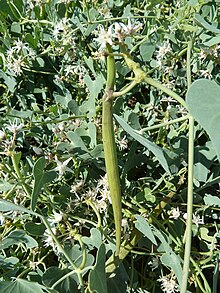
Chives, scientific name Allium schoenoprasum, is a species of flowering plant in the family Amaryllidaceae that produces edible leaves and flowers. Their close relatives include the common onions, garlic, shallot, leek, scallion, and Chinese onion.

Bidens tripartita is a common and widespread species of flowering plant in the sunflower family, Asteraceae, commonly known as three-lobe beggarticks, three-part beggarticks, leafy-bracted beggarticks or trifid bur-marigold. It is native to much of Eurasia, North Africa, and North America, with naturalized populations in Australia and on some Pacific Islands.
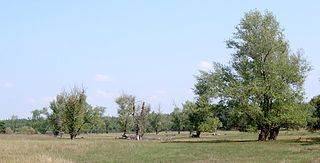
Populus nigra, the black poplar, is a species of cottonwood poplar, the type species of section Aigeiros of the genus Populus, native to Europe, southwest and central Asia, and northwest Africa.

Alnus incana, the grey alder or speckled alder, is a species of multi-stemmed, shrubby tree in the birch family, with a wide range across the cooler parts of the Northern Hemisphere. Tolerant of wetter soils, it can slowly spread with runners and is a common sight in swamps and wetlands. It is easily distinguished by its small cones, speckled bark and broad leaves.

Elymus repens, commonly known as couch grass, is a very common perennial species of grass native to most of Europe, Asia, the Arctic biome, and northwest Africa. It has been brought into other mild northern climates for forage or erosion control, but is often considered a weed.

Cynanchum is a genus of about 300 species including some swallowworts, belonging to the family Apocynaceae. The taxon name comes from Greek kynos and anchein, hence the common name for several species is dog-strangling vine. Most species are non-succulent climbers or twiners. There is some evidence of toxicity.

Osmunda regalis, or royal fern, is a species of deciduous fern, native to Europe, Africa and Asia, growing in woodland bogs and on the banks of streams. The species is sometimes known as flowering fern due to the appearance of its fertile fronds.
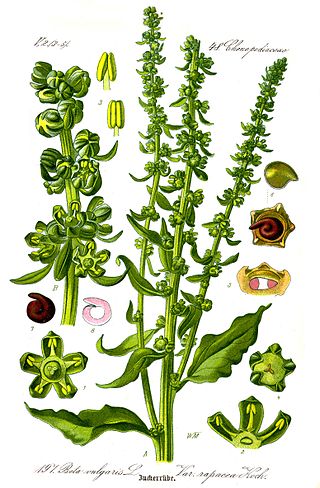
Beta is a genus in the flowering plant family Amaranthaceae. The best known member is the common beet, Beta vulgaris, but several other species are recognised. Almost all have common names containing the word "beet". Wild Beta species can be found throughout the Atlantic coast of Europe, the Mediterranean coastline, the Near East, and parts of Asia including India.
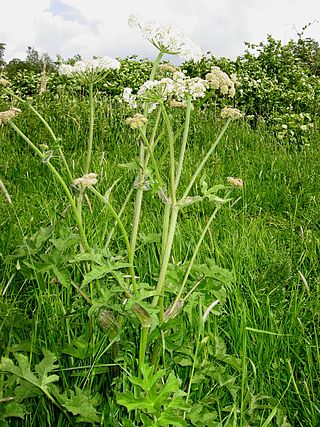
Heracleum sphondylium, commonly known as hogweed or common hogweed, is a herbaceous perennial plant in the carrot family Apiaceae, which includes fennel, cow parsley, ground elder and giant hogweed. It is native to most of Europe, western Asia and northern Africa, but is introduced in North America and elsewhere. Other common names include cow parsnip or eltrot. The flowers provide a great deal of nectar for pollinators.

Iris spuria, or blue flag, is a species of the genus Iris, part of the subgenus Limniris and the series Spuriae. It is a rhizomatous perennial plant, from Europe, Asia and Africa. It has purple or lilac flowers, and slender, elongated leaves. It is widely cultivated as an ornamental plant in temperate regions and hybridized for use in the garden. It has several subspecies; Iris spuria subsp. carthaliniae B.Mathew, Iris spuria subsp. demetrii B.Mathew, Iris spuria subsp. maritima (Dykes) P.Fourn. and Iris spuria subsp. musulmanica (Fomin) Takht. It used to have 3 other subspecies, which have now been re-classified as separate species; Iris spuria subsp. halophila, Iris spuria ssp. sogdiana and Iris spuria subsp. notha . It has many common names including 'blue iris', 'spurious iris' and 'bastard iris'.
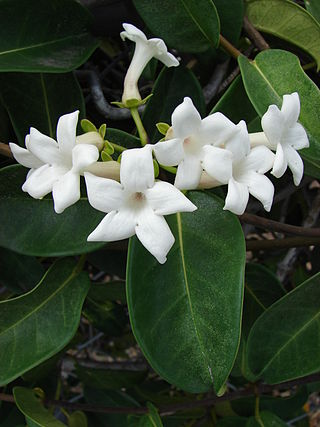
Marsdenia is a genus of plants in the family Apocynaceae first described as a genus in 1810. It is named in honor of the plant collector and Secretary of the Admiralty, William Marsden. The plants are native to tropical regions in Asia, Africa, Australia, and the Americas.

Vincetoxicum is a genus of plants in the family Apocynaceae. Although the species in Vincetoxicum have sometimes been included in Cynanchum, chemical and molecular evidence shows that Vincetoxicum is more closely related to Tylophora, now included in Vincetoxicum. The generic name means "poison-beater" in Botanical Latin because of the plants' supposed antidotal effects against snakebite.

Flueggea, the bushweeds, is a genus of shrubs and trees in the family Phyllanthaceae first described as a genus in 1806. It is widespread across much of Asia, Africa, and various oceanic islands, with a few species in South America and on the Iberian Peninsula.

Periploca is a genus of plants in the family Apocynaceae, first described for modern science by Linnaeus in 1753. It is native to Europe, Asia, and Africa.
- Periploca aphyllaDecne. - Middle East from Sinai to Pakistan
- Periploca calophylla(Wight) Falc. - S China, Nepal, Bhutan, Assam, E Himalayas, Vietnam
- Periploca chevalieriBrowicz - Cape Verde Islands
- Periploca chrysanthaD.S. Yao, X.D. Chen & J.W. Ren - Gansu Province in China
- Periploca floribundaTsiang - Yunnan, Vietnam
- Periploca forrestiiSchltr. - Guangxi, Guizhou, Qinghai, Sichuan, Tibet, Yunnan, India, Kashmir, Myanmar, Nepal
- Periploca graecaL. - Mediterranean
- Periploca hydaspidisFalc. - Kashmir
- Periploca laevigataAiton - Canary Islands, Savage Islands
- Periploca linearifoliaQuart.-Dill. & A. Rich - Ethiopia
- Periploca nigrescensAfzel. - W Africa
- Periploca refractifoliaGilli - Tanzania
- Periploca sepiumBunge - widespread across much of China
- Periploca tsiangiiD. Fang & H.Z. Ling - Guangxi Province in China
- Periploca visciformis(Vatke) K. Schum. - Somalia

Iris halophila is a species in the genus Iris, it is also in the subgenus Limniris and in series Spuriae. It is a rhizomatous perennial plant, with yellow, white or violet flowers. It is cultivated as an ornamental plant in temperate regions. It comes from a wide range from eastern Europe to China in Asia. It was known for a long while as a subspecies of Iris spuria, before being treated as a separate species in its own right.
Iris spuria subsp. musulmanica is a species of the genus Iris, part of a subgenus known as Limniris and in the series Spuriae. It is a subspecies of Iris spuria and is a rhizomatous perennial plant, from Armenia, Azerbaijan, Iran and Turkey in Asia with flowers in various shades of blue, but there are rare white forms. They have a yellow centre and darker veining. It has the common name of 'Muslim iris'. It is cultivated as an ornamental plant in temperate regions.

Iris darwasica is a plant species in the genus Iris, it is also in the subgenus Iris and in the section Regelia. It is a rhizomatous perennial, from Tajikistan and northern Afghanistan. It has long and thin glaucous to grey-green leaves, slender stem and greenish cream or greenish yellow, to dark purple or lilac flowers.

Iris attica, the Greek iris, is a plant species in the genus Iris, it is also in the subgenus Iris. It is a rhizomatous perennial, from the mountains of the Balkans in Europe, within the countries of Greece, former Yugoslavia, Turkey and North Macedonia. It has sage green or grey-green leaves, that are sickle-shaped, a stout short stem and 2 variable flowers, in shades from yellow to purple. They have a white or blue beard. It is often called Iris pumila subsp attica, but is classified in most sources, as a separate species, although it is closely related to Iris pumila, as a possible parent plant. It is cultivated as an ornamental plant in temperate regions.

Iris acutiloba is a species in the genus Iris, it is also in the subgenus of Iris and section Oncocyclus. It is a rhizomatous perennial, from the mountains of the Caucasus and found in Turkey, Armenia, Azerbaijan, Turkmenistan, Dagestan in the North Caucasus, and Iran. It is a dwarf species, with narrow, falcate or curved leaves, it has one flower in spring or early summer, that comes in shades from cream, creamy white, whitish, pale brown, light grey, to pale violet. It is heavily veined or streaked and pointed, with 2 dark spots and brown, purple, dark purple, or black short beard. It is cultivated as an ornamental plant in temperate regions. There are two subspecies, Iris acutiloba subsp. lineolata and Iris acutiloba subsp. longitepala.

Heracleum sibiricum is a species of flowering plant in the family Apiaceae. It is native to Europe and western Asia, ranging from France and Italy to western Siberia and Mongolia.
